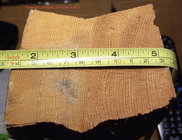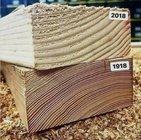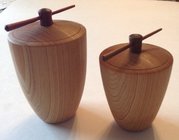-
December 2025 Turning Challenge: Single Tree! (click here for details) -
Congratulations to Bob Henrickson, People's Choice in the November 2025 Turning Challenge (click here for details) -
Congratulations to Guillaume Fontaine for "Old Tea Pot" being selected as Turning of the Week for December 15, 2025 (click here for details) -
Welcome new registering member. Your username must be your real First and Last name (for example: John Doe). "Screen names" and "handles" are not allowed and your registration will be deleted if you don't use your real name. Also, do not use all caps nor all lower case.
You are using an out of date browser. It may not display this or other websites correctly.
You should upgrade or use an alternative browser.
You should upgrade or use an alternative browser.
Wood 100 years apart
- Thread starter Alan Weinberg
- Start date
Looks to be two different species. The wood with the wide grain was bred to grow fast. Nowadays waiting so many years to grow the close grained wood is very expensive.
that was what I was showing—the tight grain example likely from an old forest, the other a modern farmed tree.bred to grow fast
- Joined
- Feb 6, 2010
- Messages
- 3,454
- Likes
- 2,523
- Location
- Brandon, MS
- Website
- threeringswoodshop.square.site
In 1918 it would have been virgin timber with no one waiting to use the wood.
- Joined
- Jul 18, 2018
- Messages
- 1,332
- Likes
- 2,875
- Location
- Baltimore, MD
- Website
- loujacobswoodturning.com
I understand your point, but, as already said, you’re comparing apples and oranges (almost literally). Southern yellow pine vs. possibly Douglas fir.
Russ Braun
TOTW Team
I can remember tight vertical grain Douglas fir at the lumber yards back in the 70’s. Then it was gone. When I asked, this spiel was this lumber was being exported to Japan for big bucks. Demand/ cost relationship in full force. This was before finger joint door jambs or OSB appeared. Of course 100% heartwood Redwood was the norm as well, try finding that these days! The evolution of lumberyard timber would make for an interesting story to some of us. The spotted owl and clear cut practices doomed what we used to take for granted!
The piece on the bottom looks like old growth Douglas Fir. The piece above could be the same. The second growth lumber doesn't come up from the deep forest, so no competition and it grows tall first, and never gets the chance to grow slow. When I first moved to Oregon, in 1969, I would see a log trucks with one log on them. Not any more.
robo hippy
robo hippy
Old growth long leaf pine window sill I salvaged from a 109 year old commercial bldg. The wood was unpainted and had a silver/gray color. Surprisingly it was only about 1/16 deep. Sanding was impossible as the resin filled the abrasive in seconds. I ended up wet sanding with mineral spirits. We could probably still have some of this to harvest in the forest if clear cutting was not the accepted practice of the day.
Attachments
We still have the tight grain in logs here, problem is that the trees are not very large, I just took a piece of Pine here out of the firewood bin, as I am sitting here with the fire going to keep the heating bills smaller.
This piece is from 2 years ago and dry, took down a few trees this past summer that will be ready by next fire season.

This piece is from 2 years ago and dry, took down a few trees this past summer that will be ready by next fire season.

nature vs nurture. trees are sujected to optimum growing conditions for maximum growth and boardfeet per year. hasnt got much to do with industrial use
a house doesnt care how tight the grain of the studs in its walls. guy here planted some hybid something trees. thing were 40 foot high in 5 or7 years and he was cutting them for firewood. the problem was that the wood was soft like styrofoam. an axe would sink in and be stuck. i think some weird hybrid poplar.. he said he was getting a cord per tree and expected to make a bundle per acre.
a house doesnt care how tight the grain of the studs in its walls. guy here planted some hybid something trees. thing were 40 foot high in 5 or7 years and he was cutting them for firewood. the problem was that the wood was soft like styrofoam. an axe would sink in and be stuck. i think some weird hybrid poplar.. he said he was getting a cord per tree and expected to make a bundle per acre.
- Joined
- Apr 27, 2004
- Messages
- 9,304
- Likes
- 6,059
- Location
- Lakeland, Florida
- Website
- www.hockenberywoodturning.com
Old growth takes centuries or mellenia to mature.
Fast growing planted slash pine has largely replaced the long leaf pine forest that dominated the coastal plane from Virginia to Louisiana.
Poorer lumber but a cash crop for pulp.
Fast growing eucalyptus were planted in clear cuts in Peru, Ecuador ,California……. Didn’t produce quality lumber and offers nothing for native wildlife.
Dade County pine was similar to longleaf pine.
“Our Reclaimed, Dade County Pine celebrates the beauty of a species that has been almost completely harvested. Therefore, most usable lumber must be found in the reclamation process. It was known to grow only in South Florida, with a range extending throughout the southern peninsula of Florida. "Pinus Elliottii Var-Densa", or Dade County Pine, as it is commonly known, has extraordinary characteristics. It is dense, strong, and highly resistant to decay and insect damage.”
Fast growing planted slash pine has largely replaced the long leaf pine forest that dominated the coastal plane from Virginia to Louisiana.
Poorer lumber but a cash crop for pulp.
Fast growing eucalyptus were planted in clear cuts in Peru, Ecuador ,California……. Didn’t produce quality lumber and offers nothing for native wildlife.
Dade County pine was similar to longleaf pine.
“Our Reclaimed, Dade County Pine celebrates the beauty of a species that has been almost completely harvested. Therefore, most usable lumber must be found in the reclamation process. It was known to grow only in South Florida, with a range extending throughout the southern peninsula of Florida. "Pinus Elliottii Var-Densa", or Dade County Pine, as it is commonly known, has extraordinary characteristics. It is dense, strong, and highly resistant to decay and insect damage.”
Last edited:
Some years back, I bought some "Lyptus" which was an engineered variation of eucalyptus that Weyerhauser developed. Trees grew to 14 to 18 inch diameter in about 10 years. I found the wood to be very splintery. Just grew too fast to be good sound wood. I don't know if it is still around or not. I don't think I would buy it again, but the pink color was nice...
robo hippy
robo hippy
worked a side job in miami when i was in grad school. old historic building with Dade pine. amazing stuff. hard like impregnated with epoxy. diasappeared near completely. pine cones will not open to drop seeds unless subjected to fire, and of course, they dont want fires through out Miami.Old growth takes centuries or mellenia to mature.
Fast growing planted slash pine has largely replaced the long leaf pine forest that dominated the coastal plane from Virginia to Louisiana.
Poorer lumber but a cash crop for pulp.
Fast growing eucalyptus were planted in clear cuts in Peru, Ecuador ,California……. Didn’t produce quality lumber and offers nothing for native wildlife.
Dade County pine was similar to longleaf pine.
“Our Reclaimed, Dade County Pine celebrates the beauty of a species that has been almost completely harvested. Therefore, most usable lumber must be found in the reclamation process. It was known to grow only in South Florida, with a range extending throughout the southern peninsula of Florida. "Pinus Elliottii Var-Densa", or Dade County Pine, as it is commonly known, has extraordinary characteristics. It is dense, strong, and highly resistant to decay and insect damage.”


